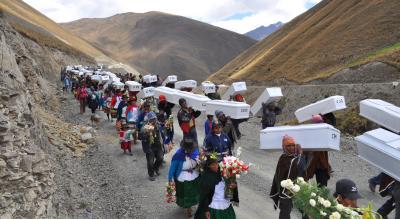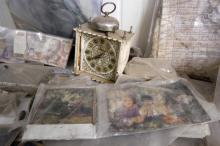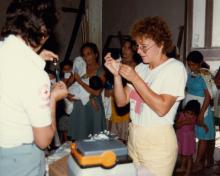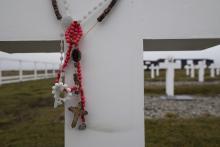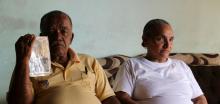Case prepared by Cristina San Juan Serrano and Eva Vaz Nave, LL.M. students at Leiden University under the supervision of Professor Robert Heinsch as well as Sofia Poulopoulou and Christine Tremblay, PhD researchers, Kalshoven-Gieskes Forum, Leiden University; with the contribution of Jemma Arman and Isabelle Gallino, LL.M. students at the Geneva Academy.
A. JOINT EFFORT TO INVESTIGATE COMMON BURIALS
“Joint work platform for the investigation on common burials
The undersigned institutions [the Peruvian Attorney General’s Office, the Ombudsman’s Office, the Truth and Reconciliation Commission, and the Human Rights National Coordination Entity], in the framework of their respective mandates and attributions, state they shall work in coordination to investigate the common burials, fundamentally aiming at contributing to the clarification of truth, the restitution of the dignity of victims and their families and the promotion of access to justice. This work will follow the parameters below:
- Work in clandestine burials shall be permanently consulted through a coordination entity made up by the Attorney General’s Office, the Truth and Reconciliation Commission, the Ombudsman’s Office and the Human Rights National Coordination Entity. The former will promote the participation of the victims’ relatives. The legal procedures related to this work will be led by the Prosecutor Specialized on Force Disappearances, Out-of-Law Executions and Clandestine Burial Exhumations.
- The procedure for working in burials will be guided by the international standards established in the relevant agreements and recommendations. To that effect, the institutions will work to adapt the procedure to said standards.
- The technical and scientific works shall include professionals from different specialties required, including doctors, pathologists, dentists, anthropologists, archeologists and forensic photographers among others. The Legal Medicine Institute and the Criminology Division of Peru’s National Police shall participate in this multidisciplinary team, together with Peruvian and foreign forensic experts.
- Independent experts shall be proposed by the Truth and Reconciliation Commission and appointed by the Attorney General’s Office. Their participation will be within the Attorney General’s Office team, in a framework of professionalism and transparency.
- The undersigning institutions will work in coordination to prepare a National Exhumation Plan to guide mid and long term work in clandestine burials. Likewise, they will prepare any standard proposal required. They also state their will to settle any disagreement based on dialogue and good faith.
- The implementation mechanism for these agreements will be part of the coordinated work among institutions signing this declaration.”
B. EXHUMATION AND HANDING OVER OF REMAINS TO FAMILIES
“Decades Later, Families Receive Remains of Victims of Peru’s Conflict
The remains of 80 people who were killed during Peru’s internal conflict with Shining Path rebels have been handed over to their families for burial, decades after their deaths. The ceremony, led by the Public Prosectuor’s Office, took place in Peru’s southern Andean region of Ayacucho, which was at the center of the bloody conflict in the 1980s and early 1990s.
The bodies of the victims were identified by forensic anthropologists, who exhumed mass graves between 2011 and 2013 in Ayacucho and used DNA to identify the individuals. Of these 80 victims, 51 were killed by the Shining Path and 29 by the state security forces. The killings occurred between 1983 and 1992, and the victims included adult men and women, two of whom were pregnant, as well as children. […]
Since 2006, when exhumations began, forensic anthropologists have recovered 2,925 bodies and have identified 1,689, with 1,485 of the victims handed over to surviving families.
The multidisciplinary investigations by forensic scientists have taken several years. To help identify the victims, the Public Prosecutor’s Office mounted an exhibition of clothing and accessories from the graves, in the hope that someone might be able to identify a sweater, a trinket or jewelry, or shoes. The identification was followed up with DNA tests, sometimes dental records, and the reports of missing persons filed at the time of the deaths. The exhibition was shown in Lima and currently is being shown in different parts of Ayacucho.
[...]
C. CREATION OF A PUBLIC REGISTRY OF BURIAL PLACES
Peru creates public registry of burial sites
After a decades-long wait for the families of the victims of the violence that was first unleashed in 1980 by the terrorist group Shining Path and turned into a conflict with the armed forces and self-defence forces until 2000, Peru’s Ministry of Justice has just approved a new regulation. The national plan for searching for missing persons will create a national registry of burial sites and establish mechanisms for searching for the remains of the victims of the conflict with the humanitarian aim of returning them to the families.
“What’s new here is the priority given to the humanitarian angle: something new is being invented in Peru, like in Sri Lanka, Nepal and Colombia. Previously, in the Balkans, the centralized mechanisms for searching for missing persons revolved around the criminal court, and the aim was justice,” explained Rafael Barrantes, an anthropologist from the International Committee of the Red Cross (ICRC) working in Peru, to El País.
The plan is necessary to implement the law on searching for missing persons that was enacted in May this year, and “the next task will be to set up a department for missing persons that will manage the national registry of missing persons and burial sites,” a source from the Ministry of Justice informed El País.
[…]
As for the number of burial sites, the Truth and Reconciliation Commission – which investigated the 20 years of violence – reported in 2003 that there were 4,644 in the country, but the non-governmental organization COMISEDH subsequently recorded 4,051 in Ayacucho department alone. It is therefore estimated that there are over 6,400 burial sites in total.
The regulation stipulates that the entity responsible for searching for missing persons will ask the authorities to protect the burial sites in order to prevent their destruction.
In Peru, between 2002 and 2016, 3,528 individuals have been exhumed and 2,084 identified, of whom a smaller number have been returned to the families for burial. However, the remains of some 900 individuals recovered during exhumations are in storage because of a lack of resources to carry out DNA tests and identify them.
The source from the Ministry of Justice stressed the importance of the preliminary work of “mapping and systematizing the existing information in order to know who to look for and how to tackle each case”.
For his part, the ICRC anthropologist specified that, to date, the information available had been “organized to demonstrate the truthfulness of the victimization” suffered by the missing persons, but the register of victims of the violence “was not designed to be used to search for those people but rather to award compensation to their families”. […]
The national plan for searching for missing persons provides that the work will be carried out with the informed consent of the relatives and that mental health support will be provided to them in their mother tongue. […]
Various sentences handed down by the Inter-American Court of Human Rights have ordered Peru [...] to locate the remains of the missing. [...]
Discussion
I. Classification of the Situation and Applicable Law
1. How would you qualify the situation in Peru, considering that the Peruvian government was fighting against the Shining Path and the Tupac Amaru Revolutionary Movement? What additional information would you require in order to make such a determination? Under which conditions would Additional Protocol II be applicable? (
GC I-IV, Art. 3;
P II, Art. 1)
II. Treatment of the Dead
2. What obligations did Peru have with regard to the treatment of the dead? To whom does it have to return the remains? How shall the remains be disposed of? (
CIHL, Rules 112-117) Based on the information in these documents, did Peru comply with these rules? Do the same rules apply to non-state armed groups?
3. What rights do the families of the missing in Peru have under IHL? Do they have a right to information? (
CIHL, Rule 117; in IACs, see also
P I, Art. 32)
4. What are the purposes of the exhumations? To inform the families that their relatives are dead? To convince the families that their relatives are dead? To provide the families with the remains of their relatives? To establish by whom and how the dead persons were killed? Are these aims always compatible or do they sometimes contradict each other?
5. (Document C) What is the aim of the National Registry established by Peru? Do parties to the conflict have an obligation to mark the location of the graves? Is this rule customary? (
CIHL, Rule 116)
III. Elements Contributing to Respect for IHL
6. (Document A) What do you think of the initiative of the Truth and Reconciliation Commission, in collaboration with other entities, to carry out investigations and exhumation of dead related to the conflict? Why is it important, even long after the end of hostilities? For the relatives of the dead? For society in general? For the government ordering the exhumation?
7. (Document B) What do you think of the idea of carrying out public exhumations accompanied by a public ceremony? Why do you think the government of Peru opted for this type of exhumation?
8. Document C refers to judgments against Peru by the Inter-American Court of Human Rights. Do you think these decisions had an impact on Peru’s initiatives in practice? Can regional Human Rights tribunals have a positive impact on the implementation of IHL in general?

